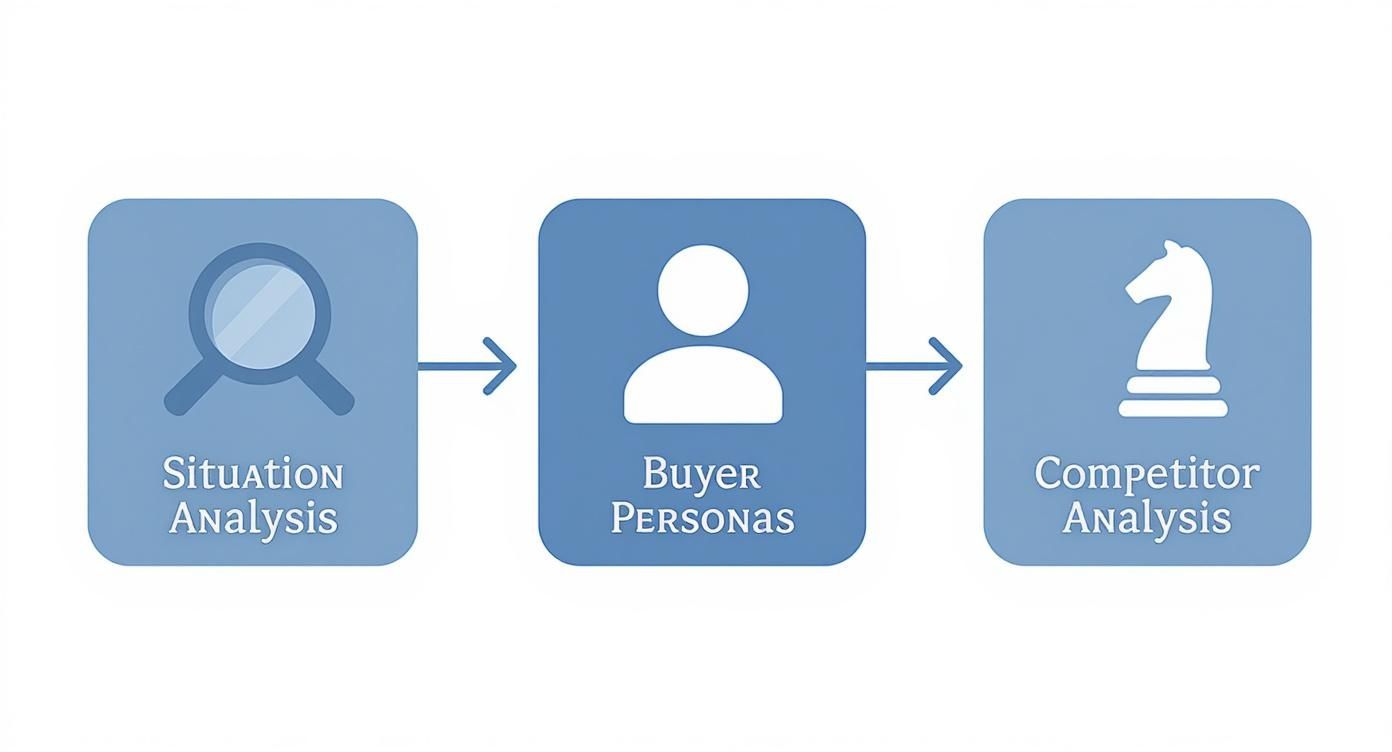
How to Write a Marketing Plan That Actually Works
October 27, 2025
Before you write a single objective, you have to know where you stand. This first phase is all about gathering the intel that will inform every other decision in your marketing plan. Think of it as the essential groundwork for a strategy built on hard evidence, not just assumptions.
Building Your Foundation with Strategic Research
Jumping straight into tactics without doing your homework is like setting sail without a map. Sure, you're moving, but you have no idea if you're heading in the right direction. Strategic research grounds your plan in reality, pointing your efforts where they’ll actually make a difference. This whole process really boils down to three core activities: analyzing your own situation, defining your customer, and sizing up the competition.
This visual flow shows how each research step builds on the last—from looking inward to understanding your audience and the competitive landscape.

Starting with a broad situation analysis helps you zero in on specific customer segments and competitive gaps that represent your biggest opportunities.
Conduct a Practical Situation Analysis
A situation analysis is just a fancy way of saying you need a high-level view of your current position. The best tool for this, hands down, is the classic SWOT analysis. It’s a straightforward way to organize your thoughts around your company's internal and external factors.
- Strengths (Internal): What do you do exceptionally well? This could be a unique product feature, a super-skilled team, or a strong brand people already recognize.
- Weaknesses (Internal): Where are you falling short? Be brutally honest about things like resource limitations, gaps in your team's expertise, or a weak market presence.
- Opportunities (External): What’s happening out in the world that you can take advantage of? Think about new tech, shifting consumer habits, or market segments that nobody else is serving well.
- Threats (External): What external factors could trip you up? This includes new competitors popping up, negative market trends, or even shifts in government regulations.
Your SWOT analysis shouldn't be a one-and-done exercise. A small business, for instance, might identify its agility as a strength but its tiny budget as a weakness. The opportunity could be a competitor's recent price hike, while the threat is a new, well-funded startup entering the scene.
Build Detailed Buyer Personas
Once you have a handle on your internal landscape, it's time to get incredibly specific about who you're trying to reach. Moving beyond basic demographics is absolutely critical. Buyer personas are basically semi-fictional profiles of your ideal customers, built from market research and real data you already have.
A truly useful persona goes deep into the motivations and pain points of your audience. For a B2B software company, a persona might be "Marketing Manager Molly." Instead of just listing her age and job title, you’d dig into her daily challenges (like proving ROI or managing a small team) and her professional goals (getting that promotion, launching killer campaigns). This kind of depth is what helps you craft messaging that actually connects. To learn more, check out our guide on what is audience analysis and how to apply it.
This level of detail is what ensures your marketing efforts speak directly to the people who matter most.
Analyze Your Competitors to Find Gaps
Finally, you need to know who you're up against. Competitor analysis isn't about copying what others are doing—it's about finding what they aren't doing. Pinpoint your top 3-5 direct and indirect competitors and start dissecting their strategies.
Take a hard look at their:
- Messaging and Positioning: What unique value are they claiming? How do they talk about their products?
- Content Strategy: What topics are they covering on their blog? What kinds of videos or social media content are they putting out?
- Customer Reviews: What do customers love about them? Even better, what are the common complaints? Those complaints are often where your biggest opportunities are hiding.
When you're building this foundation, a robust game plan is crucial. A focused article on a startup digital marketing strategy can offer valuable frameworks, especially for new ventures. By identifying a gap—maybe your competitors all target huge enterprise clients, leaving small businesses completely underserved—you can position your brand as the go-to solution for that specific niche. This kind of strategic positioning is born directly from thorough research and gives your plan a powerful, durable edge.
Setting Clear Goals and Defining Success

Alright, you’ve done your homework. The research is complete, and you have a solid grasp of where your business stands. Now it's time to turn all that insight into action.
This is the point where we shift from analysis to ambition. A marketing plan without clear goals is just a collection of nice ideas—it has no teeth, no direction, and no way to tell if you're actually winning.
Vague goals like “get more leads” or “boost brand awareness” are a recipe for frustration. They’re a starting point, sure, but they’re not a finish line. To make a real impact, you have to turn those fuzzy wishes into concrete targets your team can rally behind.
Embracing the SMART Framework
The best way I’ve found to do this is with the SMART framework. It’s a classic for a reason. This simple filter forces you to create goals that are Specific, Measurable, Achievable, Relevant, and Time-bound. It’s the difference between a wish and a plan.
Let’s walk through a real-world example. Imagine a small e-commerce shop selling handmade leather goods. Their initial thought is, "We need to sell more bags."
Here’s how we can sharpen that using SMART:
- Specific: "Sell more bags" is too broad. Let's get specific: "Increase online sales of our new 'Weekender' leather duffel bag."
- Measurable: How will we know we succeeded? Let's add a number: "Increase online sales... by 25%."
- Achievable: Is 25% even possible? If you saw 5% growth last quarter, a 25% jump is ambitious but not impossible, especially with a focused campaign behind it. It's a stretch, not a fantasy.
- Relevant: How does this goal help the bigger picture? "This sales increase will directly contribute to our company-wide objective of 15% revenue growth this year."
- Time-bound: What's the deadline? "Increase online sales... within the next fiscal quarter (Q3)."
Put it all together, and you get a goal that’s impossible to misunderstand: "Increase online sales of our new 'Weekender' leather duffel bag by 25% in Q3 to support our company-wide 15% revenue growth target." Now that's a mission.
Connecting Goals to Key Performance Indicators
With your SMART goals in hand, the next step is picking the right Key Performance Indicators (KPIs). Think of KPIs as the numbers on your dashboard that tell you if you're on track. Choosing them upfront is critical—it stops you from chasing vanity metrics (like social media likes) that feel good but don't actually move the needle.
Your KPIs must tie directly to your goals. If your goal is to generate leads, you should be tracking MQLs, not just website traffic.
A common mistake is tracking too many things. For each goal, pick just 2-3 primary KPIs that give you the clearest signal of success. Everything else is just noise.
This tight alignment ensures every marketing dollar and hour is spent with purpose. And with AI playing a bigger role in marketing, getting this right is more important than ever. The global AI marketing market is expected to hit $40 billion by the end of 2025, as smaller businesses ramp up their AI spending by 25% each year to stay competitive. You can dig into more of these AI marketing trends on cubeo.ai.
To make this crystal clear, here’s how different marketing goals connect directly to specific, measurable KPIs.
Connecting Marketing Goals to Core KPIs
This table shows how you can link your high-level objectives to the metrics that truly matter.
| Marketing Goal | Primary KPI | Example Metric |
|---|---|---|
| Increase Brand Awareness | Social Media Reach | Total impressions on campaign posts per month |
| Generate Qualified Leads | Marketing Qualified Leads (MQLs) | Number of demo requests from the website |
| Boost Customer Loyalty | Customer Lifetime Value (CLV) | Average purchase value x average purchase frequency |
| Improve Website Traffic | Unique Monthly Visitors | Number of new users visiting the blog |
When you define exactly what success looks like from the start, you build a marketing plan that’s both strategic and accountable. It's how you ensure every bit of effort pushes your business forward.
Choosing Your Marketing Channels and Tactics
With your goals nailed down and your KPIs ready to go, it’s time to build the engine that actually drives your results. This is where you decide how you’re going to reach your audience.
Choosing the right marketing channels and tactics isn't about being everywhere at once. It's about being in the right places, consistently.
Your channels are the roads to your customers—think social media, search engines, or their email inbox. Your tactics are the specific things you do on those roads, like running a Facebook ad campaign or publishing an SEO-optimized blog post. The real magic happens when you get these two working together.
Find Your Audience Where They Already Are
The biggest mistake I see marketers make is chasing trends. Just because a new social platform is blowing up doesn't mean your audience is there. Your buyer personas—the ones you developed earlier—are your compass here.
If you’re selling B2B software to marketing managers, LinkedIn and niche industry blogs are probably your best bet. If you're a direct-to-consumer brand selling handmade jewelry, you need to be on Instagram and Pinterest. Don't try to force your audience to find you; go where they already spend their time.
Building a real connection on these platforms is what sets you apart. In fact, 58% of consumers say they find new businesses through social media. Weaving authentic storytelling into your campaigns can give you a serious leg up. You can discover insights about global marketing on welocalize.com to see where things are headed.
Build an Integrated Marketing Ecosystem
The most effective marketing plans don't treat channels like separate silos. Instead, they create a cohesive ecosystem where every channel supports and amplifies the others. This is the heart of an integrated marketing strategy. It keeps your brand message consistent and makes sure your efforts build on one another.
Think of it like a wheel. Your core content is the hub, and your channels are the spokes.
- Hub (Pillar Content): This is a massive piece of content—an in-depth guide, an original research report, or a comprehensive webinar.
- Spokes (Distribution Channels): These are all the channels you use to promote and chop up that pillar content.
Let me show you what I mean.
Imagine you create a pillar blog post titled "The Ultimate Guide to Remote Team Productivity." This one asset can be sliced, diced, and distributed across a dozen channels to maximize its reach, ensuring every part of your strategy works together.
Work Smarter: Repurpose Everything
Repurposing isn't about being lazy. It’s about being smart and getting the most mileage out of the hard work you’ve already done.
Here’s how that one pillar post can fuel an entire month’s worth of marketing:
Email Marketing: Send a summary of the guide to your email list with a link back to the full article. This drives traffic and keeps your subscribers engaged. A strong email is essential, and you can get some great ideas from our guide on how to write a marketing email that converts.
Social Media Content: Break down the guide's best insights into 10-15 bite-sized social media posts. Think quote graphics, short video clips explaining a concept, or a poll based on a key statistic from your guide.
Video Script: Turn the main sections of the post into a script for a short YouTube video. This is perfect for the audience members who would rather watch than read.
Infographic: Visualize the most important data points or steps in a slick, professional infographic. These are incredibly shareable on platforms like Pinterest and can even help you earn valuable backlinks.
This approach makes sure your message hits people from multiple angles, reaching them in the format they actually prefer.
Prioritize with an Effort vs. Impact Matrix
Okay, you have a long list of potential tactics. Now what? You can't do everything at once.
An effort vs. impact matrix is a dead-simple but powerful tool for figuring out where to start. You just sort your ideas into four buckets:
| Quadrant | Description | Example Tactic |
|---|---|---|
| High Impact, Low Effort | Quick Wins: These are your top priorities. Do them now. | Repurposing an existing blog post into a social media carousel. |
| High Impact, High Effort | Major Projects: Big, strategic initiatives that require serious resources but promise huge returns. | Launching a comprehensive video course or a flagship research report. |
| Low Impact, Low Effort | Fill-ins: Nice-to-have tasks you can tackle when you have spare time. Not critical. | Updating old social media profile descriptions. |
| Low Impact, High Effort | Time Sinks: Avoid these at all costs. They drain your resources with almost nothing to show for it. | Manually tracking vanity metrics across ten different platforms. |
By plotting your ideas on this grid, you immediately see where to focus your energy first. It’s a game-changer for keeping your team focused on activities that actually move the needle.
Creating a Realistic Marketing Budget

Your strategy and goals are the engine of your marketing plan, but let's be honest—the budget is the fuel. Without it, even the most brilliant ideas are going nowhere.
Building a realistic budget isn't about reining in your ambition. It’s about giving it a financial roadmap so you can actually turn your strategy into reality. This is where you put a price tag on your objectives, making sure you have the resources to get things done without any nasty surprises.
Plus, a well-planned budget is your best tool for proving marketing's return on investment (ROI) to the people holding the purse strings.
Choosing the Right Budgeting Model
There’s no single "right" way to set a marketing budget. The best approach really depends on your company’s size, industry, and overall financial situation. Let's walk through a few of the most common models I've seen in the wild.
Percentage of Revenue: This is the most straightforward method. You simply dedicate a fixed percentage of your company's revenue to marketing. A common range is 5-12%, but this can swing wildly. A startup in a high-growth phase might push that to 20% or more, while an established company in a mature market could sit at the lower end.
Objective-Based Costing: This is my personal favorite because it’s the most strategic. Instead of starting with a top-down number, you build from the bottom up. You define your goals first (like, "we need to generate 500 new leads this quarter") and then figure out what it will cost to achieve them. This approach directly ties your spending to actual results.
Competitor-Based Budgeting: This one is all about keeping up with the Joneses. You set your budget based on what your competitors are spending. While it can help you maintain your share of voice, it’s a purely reactive move. It also assumes your competitors know what they're doing and that their goals are the same as yours—which is a pretty big gamble.
A hybrid approach usually works best. You might start with a percentage of revenue to get a ballpark figure, then sharpen your pencil with objective-based costing to make sure every dollar is aligned with your specific goals.
Allocating Your Budget: A Real-World Example
Okay, so you’ve landed on a total number. Now for the fun part: slicing it up. Where does the money actually go?
To make this tangible, let's imagine a B2B SaaS startup with a $5,000 monthly marketing budget. Their main goal is to generate leads. Here’s one way they could break that down.
Sample Monthly Marketing Budget Breakdown
This table gives you a practical look at how that $5,000 could be allocated. It's just an example, but it shows how you can assign funds to specific activities that support your primary goal.
| Marketing Activity | Percentage of Budget | Example Cost Items |
|---|---|---|
| Content Creation | 30% ($1,500) | Hiring a freelance writer for two blog posts and one case study. |
| Paid Advertising | 40% ($2,000) | LinkedIn ads targeting specific job titles and industries. |
| Software & Tools | 15% ($750) | Subscriptions for an email marketing platform, SEO tool, and social media scheduler. |
| Contractor Fees | 10% ($500) | Paying a part-time virtual assistant for social media management. |
| Contingency Fund | 5% ($250) | Reserved for unexpected opportunities or to double down on a winning ad campaign. |
This kind of breakdown gives you a clear financial plan and also highlights just how critical the right technology is. Customers expect personalized experiences, and that means you need a solid tech stack to deliver.
In fact, investment in the tech needed to unify marketing data is predicted to triple by 2025 as businesses get more serious about data-driven insights. You can learn more about these marketing statistics on salesforce.com to see how trends like this are shaping budget decisions.
Remember, your budget is a living document, not something you set in stone. Review it at least quarterly. Be ready to shift funds from underperforming channels to the ones that are crushing it. This agile approach is how you truly maximize your marketing ROI.
Executing Your Plan and Measuring Performance
A brilliant marketing plan sitting in a shared drive is useless.
The most critical part of this whole process isn't just writing the plan—it's bringing it to life. This is where your strategy gets real, tested by disciplined execution, careful monitoring, and a willingness to adapt when the data tells you to. The goal isn't just to launch campaigns; it's to build a system for continuous improvement.
From Document to Action Plan
First things first, you need to translate your big-picture strategy into day-to-day tasks. A simple spreadsheet or a project management tool like Trello or Asana works wonders here, turning a static document into a dynamic roadmap.
Your action plan should break every major initiative into smaller, more manageable steps. For each one, you need to be crystal clear on three things:
- What is the task? Get specific. "Do social media" is a wish. "Draft and schedule three Instagram posts for the new product launch" is a task.
- Who is responsible? Assign a single owner to every task. This simple step eliminates confusion and creates real accountability.
- When is it due? Deadlines keep everything moving forward. No deadline, no urgency.
This simple process turns your strategic document into a living, breathing project plan that guides your team’s daily priorities.
Establish a Rhythm for Performance Reviews
A marketing plan is not a "set it and forget it" document. The market changes, campaigns flop, and new opportunities pop up out of nowhere. To stay on top of it all, you need a consistent rhythm for reviewing your performance.
Whether you choose a monthly or quarterly review depends on your business cycle, but consistency is what really matters. The whole point of these meetings is to look at the data, have honest conversations about what’s working, and make smart decisions about what to do next.
A common mistake is treating these reviews as a simple reporting session. Instead, they should be strategic discussions focused on one question: "Based on what we've learned, what should we change?"
These check-ins are where you build agility into your marketing. They give you the structure to pivot away from underperforming tactics and double down on the channels delivering the best results.
Building Your KPI Dashboard
To have productive reviews, you need data. This is where your Key Performance Indicators (KPIs) come back into play. You have to set up a dashboard—whether in Google Analytics, a CRM, or a dedicated reporting tool—that tracks the metrics you defined earlier.
Your dashboard should give you an at-a-glance view of your marketing health. Don't get lost in vanity metrics; focus on the core KPIs tied directly to your SMART goals.
A few essential metrics you'll likely want to track include:
- Customer Acquisition Cost (CAC): How much does it actually cost you to win a new customer?
- Conversion Rate: What percentage of people visiting your site are taking the action you want them to? (e.g., filling out a form, making a purchase).
- Return on Ad Spend (ROAS): For every dollar you put into ads, how much revenue are you getting back?
- Marketing Qualified Leads (MQLs): How many high-quality leads is your marketing team generating for sales?
Tracking these numbers is the only way to know if your plan is actually working. For a deeper dive, our guide on measuring content effectiveness offers some great frameworks for connecting your efforts to real business outcomes.
The Cycle of Measurement and Optimization
Great execution isn't a straight line; it’s a continuous loop of action, measurement, and optimization. This is how you make intelligent adjustments in real-time, ensuring your marketing gets more effective over time.
The cycle is simple:
- Execute: Launch your campaigns based on the action plan.
- Measure: Collect the data on your KPIs using your dashboard.
- Analyze: In your review meetings, dig into the data to understand why you're seeing certain results.
- Optimize: Based on that analysis, make informed changes. Maybe you tweak your ad copy, reallocate your budget, or even try a new channel altogether.
By embracing this cycle, your marketing plan becomes a powerful tool for growth, not just a document that looks good on paper. It's the final, crucial step to ensuring your strategy delivers tangible results.
Got Questions About Your Marketing Plan? Let's Unpack Them.

As you start piecing together your strategy, a few questions almost always pop up. It's totally normal. Working through these common hurdles is just part of the process, and getting clear answers now will make your final plan that much stronger.
How Often Should I Update My Marketing Plan?
Think of your marketing plan as a living document, not a stone tablet. You create it, you use it, and you definitely change it. Markets shift, customers change their minds, and your own business goals evolve. Your plan needs to keep up.
A good rhythm I've seen work well is a light review every quarter. This is your quick check-in. Are you hitting your KPIs? Are your campaigns performing like you thought they would? It's the perfect time for small tactical tweaks.
Then, do a much bigger overhaul once a year. This is where you dust off everything—from your SWOT analysis to your budget—and make sure the whole thing aligns with your company's big goals for the year ahead. But of course, if something major happens, like a surprise competitor or a massive industry shift, don't wait. Dive back in immediately.
What's the Biggest Mistake to Avoid?
If there’s one killer mistake I see over and over, it’s building a plan on pure guesswork. When you skip the hard work of researching your audience, your competitors, and the market itself, your entire strategy is just a house of cards. That's why the initial research phase is non-negotiable.
Another classic pitfall? Creating a plan that's way too rigid. The market loves to throw curveballs, and a plan without any wiggle room will quickly become obsolete.
The best plans are built on data but designed for agility. They give your team a clear roadmap but leave enough space to pivot when something isn't working. Don't be afraid to pull the plug on a tactic that's flopping and move that budget to something that is.
How Detailed Should My Marketing Plan Be?
Your plan needs to be detailed enough for your team to understand the goals, their roles, and what success looks like. The real focus should be on clarity and actionability, not page count.
A lean startup might have a sharp, focused plan that’s just 10-15 pages. A huge enterprise with a dozen product lines? Theirs will naturally be a much bigger document. The trick is to cut out the fluff.
Make it comprehensive enough to provide real direction, but simple enough that people will actually pull it out and use it. For a bit more context on how this fits into the bigger picture, you might find some useful nuggets in guides on how to write a business plan, which helps place your marketing strategy within the wider company vision.


